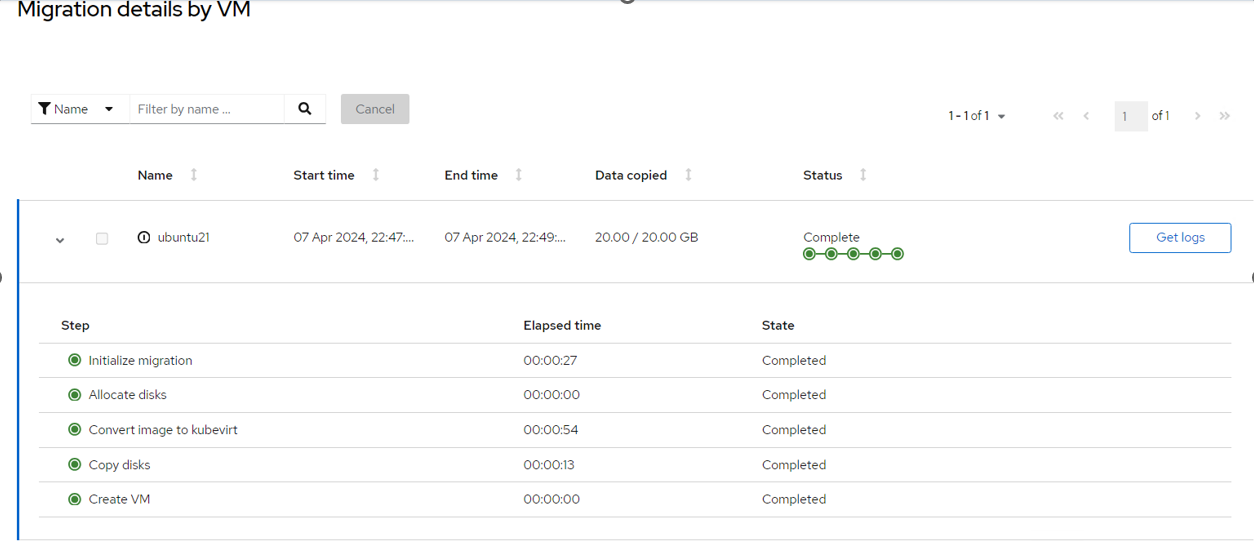OpenShift Virtualization
Install and Configure Openshift Virtulization
Introduction
RedHat OpenShift Virtualization stands as a cornerstone of Red Hat's OpenShift Container Platform, seamlessly blending virtual machines and containers to offer a unified management interface. This integration empowers organizations to efficiently deploy both modern and traditional applications, encompassing virtual machines, containers, and serverless functions within a single platform. Built upon the "container-native virtualization" concept, driven by the KubeVirt project, it harnesses the RHEL KVM hypervisor to seamlessly merge virtual machines with Kubernetes and KubeVirt for streamlined management and orchestration. Through this infrastructure, OpenShift Virtualization enables the coexistence of virtual machines and containers within a Kubernetes environment, providing a cohesive solution for workload management.
OpenShift Virtualization adds new objects into your OpenShift Container Platform cluster via Kubernetes custom resources to enable virtualization tasks. These tasks include:
Creating and managing Linux and Windows virtual machines
Connecting to virtual machines through a variety of consoles and CLI tools
Importing and cloning existing virtual machines
Managing network interface controllers and storage disks attached to virtual machines
Live migrating virtual machines between nodes
An enhanced web console provides a graphical portal to manage these virtualized resources alongside the OpenShift Container Platform cluster containers and infrastructure.
OpenShift Virtualization is tested with OpenShift Data Foundation (ODF) and Alletra MP Storage.
OpenShift Virtualization allows the usage with either the [OVN-Kubernetes] (opens new window)or the [OpenShiftSDN] (opens new window)default Container Network Interface (CNI) network provider
Enabling OpenShift Virtualization

FIGURE 33 Red Hat OpenShift Virtualization deployment flow
Installing OpenShift Virtualization Operator from OperatorHub
Log into the OpenShift Container Platform web console and navigate to Operators → OperatorHub
Type OpenShift Virtualization and Select OpenShift Virtualization tile

FIGURE 34 OpenShift Virtualization in OperatorHub
- Click and Install the Operator to the "openshift-cnv" namespace

FIGURE 35 Inputs for the OpenShift Virtualization operator
- Once OpenShift Virtualization is successfully installed , Create HyperConverged Custom resource


FIGURE 36 Creation of HyperConverged in OpenShift Virtualization operator
After successful deployment of operator and creation of HyderConverged. Virtualization will be enabled in webconsole.
Network configuration
You would have internal pod network as default network after successful deployment of OpenShift Virtualization. For additional network, we would deploy the network operator "NMState Operator" and configure Linux bridge network for external VM access and live migration.
Administrators can also install SR-IOV Operator to manage SR-IOV network devices and MetalLB Operator for lifecycle management.
Configuring a Linux bridge Network
To install NMState Operator, navigate to Operators → OperatorHub in webconsole
Type NMState, Select Kubernetes NMState Operator tile and Install the Operator

FIGURE 37 Installation of NMState in OperatorHub
- Once the NMState operator is installed, Create a instance for "nmstate"

FIGURE 38 Inputs for NMState in operator
Creating a Linux bridge NNCP
Create a NodeNetworkConfigurationPolicy (NNCP) manifest for a Linux bridge network for network interface card(enp1s0) and apply the created NNCP manifest
apiVersion: nmstate.io/v1
kind: NodeNetworkConfigurationPolicy
metadata:
name: br1-policy
spec:
desiredState:
interfaces:
- name: bridge1
type: linux-bridge
state: up
ipv4:
dhcp: true
enabled: true
bridge:
options:
stp:
enabled: false
port:
- name: enp1s0 #NIC/Bond
Creating a Linux bridge NAD
Log in to the OpenShift Container Platform web console and click Networking → NetworkAttachmentDefinitions
Click Create Network Attachment Definition (NAD). And provide the required details
Click the Network Type list and select CNV Linux bridge
Enter the name of the bridge (Previously created NodeNetworkConfigurationPolicy object as interfaces name ex: bridge1) in the Bridge Name field
Click Create
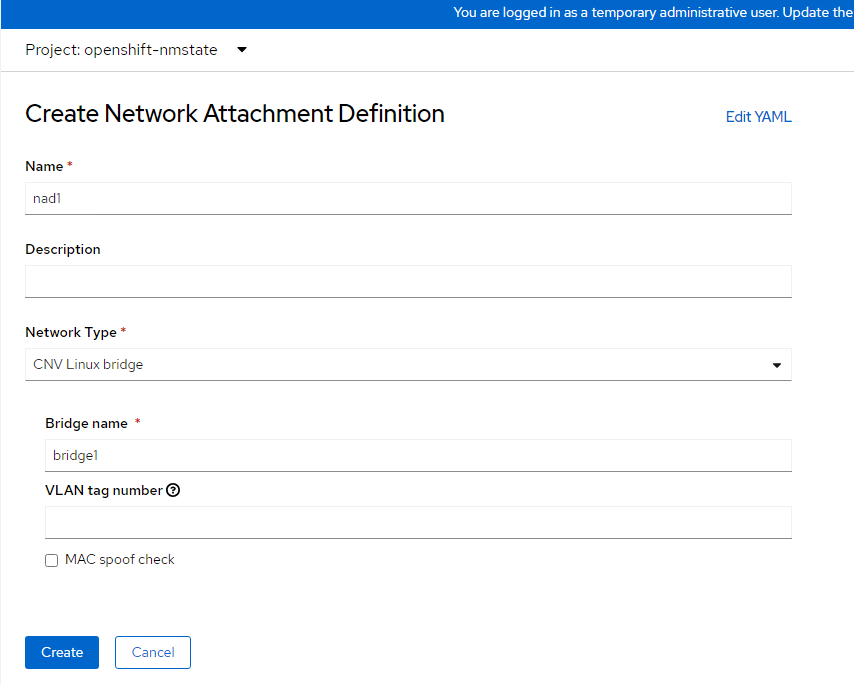
FIGURE 39 Creation of NAD
Creating a dedicated network for live migration
- Administrators have to create additional NAD for creating a dedicated live migration network. Create a NAD manifest as below
apiVersion: "k8s.cni.cncf.io/v1"
kind: NetworkAttachmentDefinition
metadata:
name: migration-network
namespace: openshift-cnv
spec:
config: '{
"cniVersion": "0.3.1",
"name": "migration-bridge",
"type": "macvlan",
"master": "enp1s1",
"mode": "bridge",
"ipam": {
"type": "whereabouts",
"range": "20.0.0.0/24"
}
}'
- Goto the custom resource of Hydercoverged that was created during "OpenShift Virtualization" operator deployment and Specify the created network name for "spec.liveMigrationConfig"
apiVersion: hco.kubevirt.io/v1beta1
kind: HyperConverged
metadata:
name: kubevirt-hyperconverged
spec:
liveMigrationConfig:
completionTimeoutPerGiB: 800
network: migration-network #specify migration network name
parallelMigrationsPerCluster: 5
parallelOutboundMigrationsPerNode: 2
progressTimeout: 150
Create a virtual machine
The web console features an interactive wizard that guides you through General, Networking, Storage, Advanced, and Review steps to simplify the process of creating virtual machines. All required fields are marked by a *. When the required fields are completed, you can review and create your virtual machine.
Network Interface Cards (NICs) and storage disks can be created and attached to virtual machines after they have been created.
Use one of these procedures to create a virtual machine:
Creating virtual machines from templates
Creating virtual machines from instance types
Creating virtual machines from CLI
Creating virtual machines from templates
You can create virtual machines from templates provided by Red Hat using web console. You can also create customized templates as per requirements.
- Log into the OpenShift Container Platform web console and navigate to Virtualization → Catalog → Template Catalog
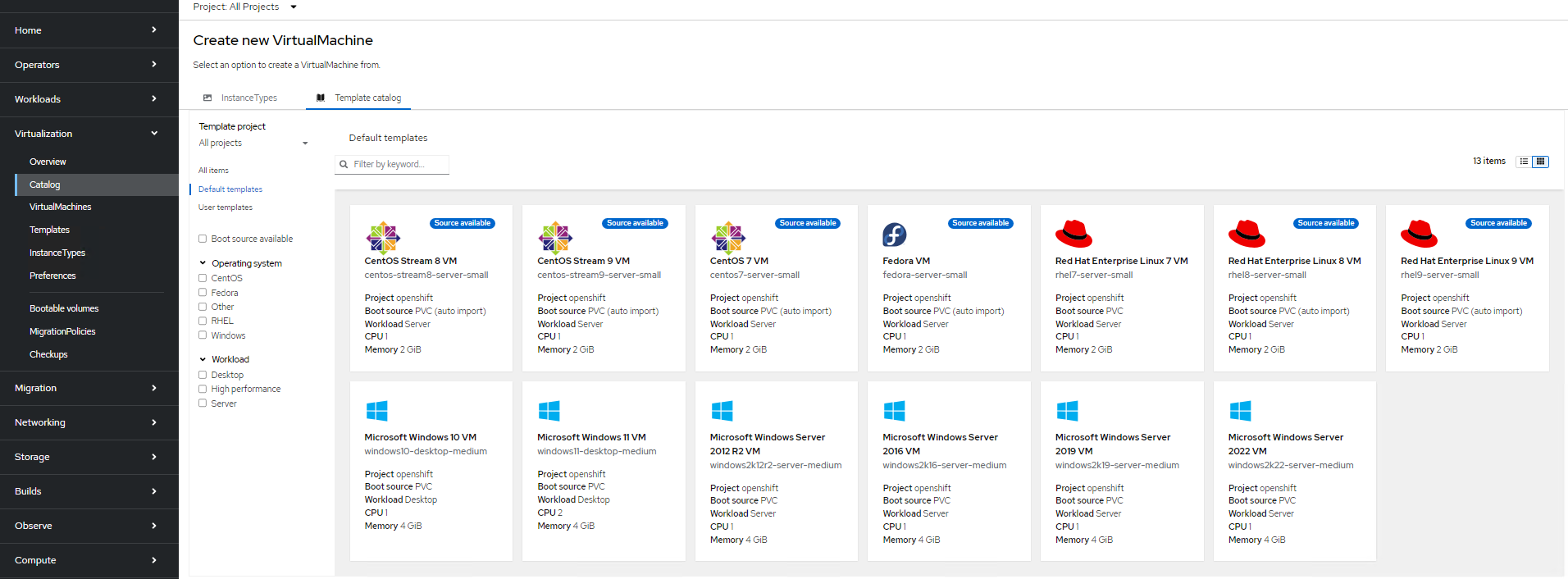
FIGURE 40 Templates available by default in Virtualization
Apply the filter "Boot source available".
Click the required template to view the details (for example: fedora)
Click "Quick create VirtualMachine" to create a VM from the template. You can customize the CPU/Memory/Storage as required.
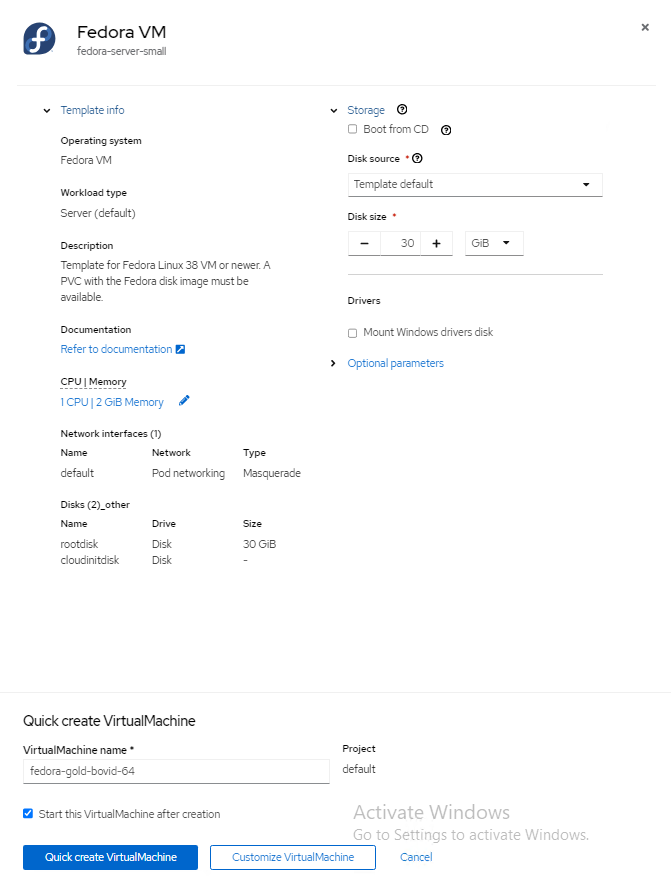
FIGURE 41 Sample deployment of fedora VM using templates
Creating virtual machines from instance types
- Log into the OpenShift Container Platform web console and navigate to Virtualization → Catalog → Instance Types

FIGURE 42 Virtual Machine creation from Catalog
Select the bootable volumes
- Images provided by RedHat, these images are available in "openshift-virtualization-os-images" namespace.
- Click Add Volume. You can either use any of the existing volume where you have the boot images or you can upload images and create a new volume(PVC) and provide the required parameter.
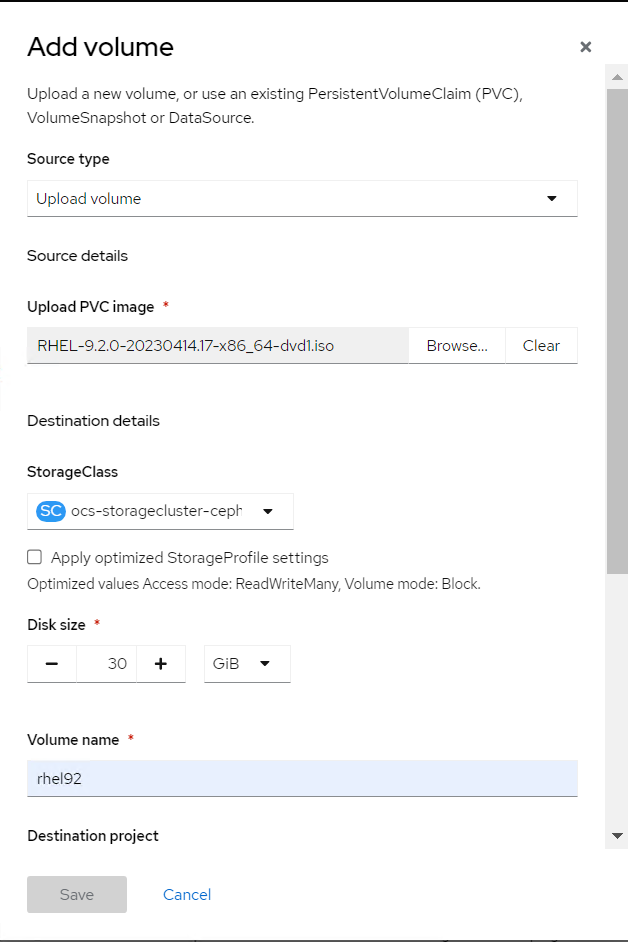
FIGURE 43 Add volumes to import OS images
Click the required boot volume.
Select the required Instance type
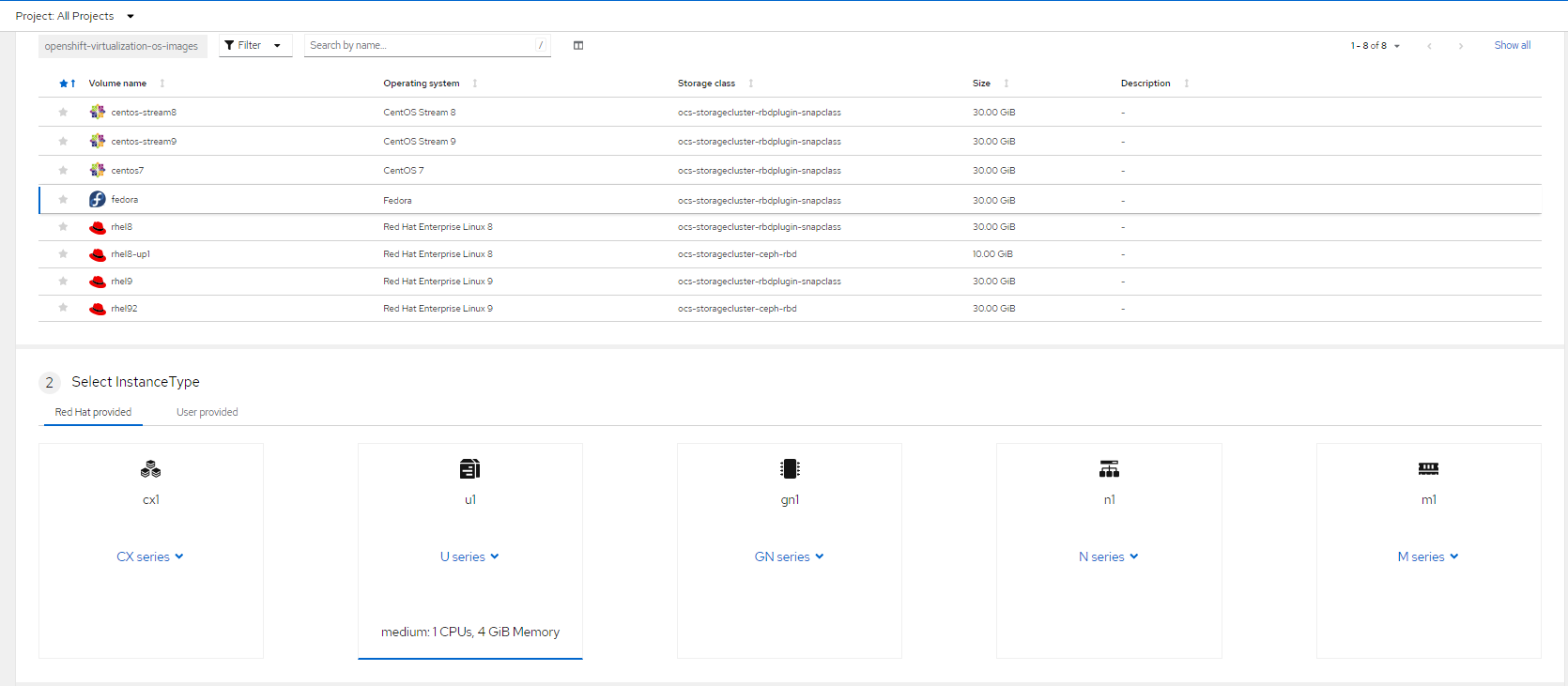
FIGURE 44 Selection of Instance type and boot image
- Click "Create VirtualMachine" to create a VM from the instance types.
You can Customize and create user Instance type as required by navigating to Virtualization → Instance Types → Create.
Creating virtual machines from CLI
- Create a VirtualMachine manifest required for creating a VM
Below is an example manifest for creating fedora VM
apiVersion: kubevirt.io/v1
kind: VirtualMachine
metadata:
name: my-vm
spec:
running: false
template:
metadata:
labels:
kubevirt.io/domain: my-vm
spec:
domain:
devices:
disks:
- disk:
bus: virtio
name: containerdisk
- disk:
bus: virtio
name: cloudinitdisk
resources:
requests:
memory: 8Gi
volumes:
- name: containerdisk
containerDisk:
image: kubevirt/fedora-cloud-registry-disk-demo
- name: cloudinitdisk
cloudInitNoCloud:
userData: |
#cloud-config
password: fedora
chpasswd: { expire: False }
- Apply the created manifest file for virtual machine creation.
oc apply -f < file-name >.yaml
Reading/Viewing virtual machine
You can check the virtual machine status, Metrics , resources utilization (CPU, memory, storage) for overall cluster by navigate to Virtualization → Overview.
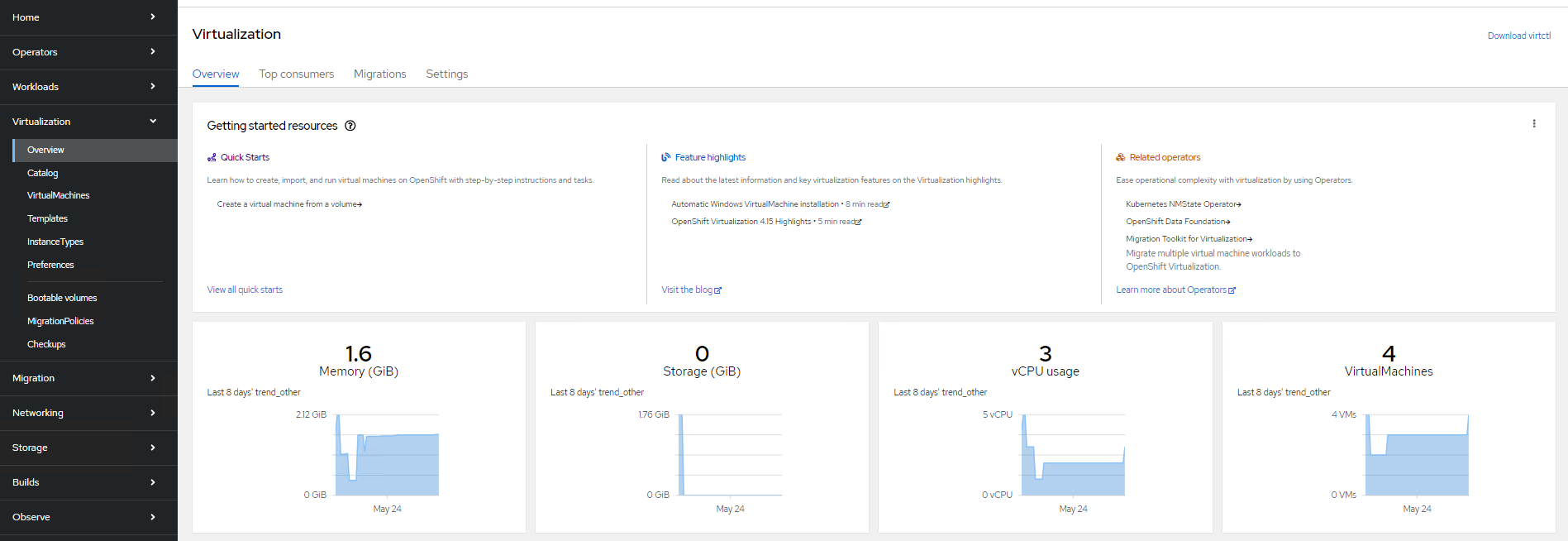
FIGURE 45 Overview Virtual machines in the Cluster
and access configuration details of VM's, networks and storage volumes.

FIGURE 46 Overview of Sample Virtual machines deployed in the RHOCP platform
Updating a virtual machine
You can update virtual machine configuration using CLI or from the web console.
virtual machine configuration using CLI
- Virtual machine configuration can be edit/updated
oc edit vm < vm-name > -n < namespace >
- Apply the updated configuration
oc apply vm < vm_name > -n < namespace >
virtual machine configuration using web console
Log into the OpenShift Container Platform web console and navigate to Virtualization → VirtualMachines
Select the virtual machine For example: addition of the disk navigate to Configuration → Storage → Add disk
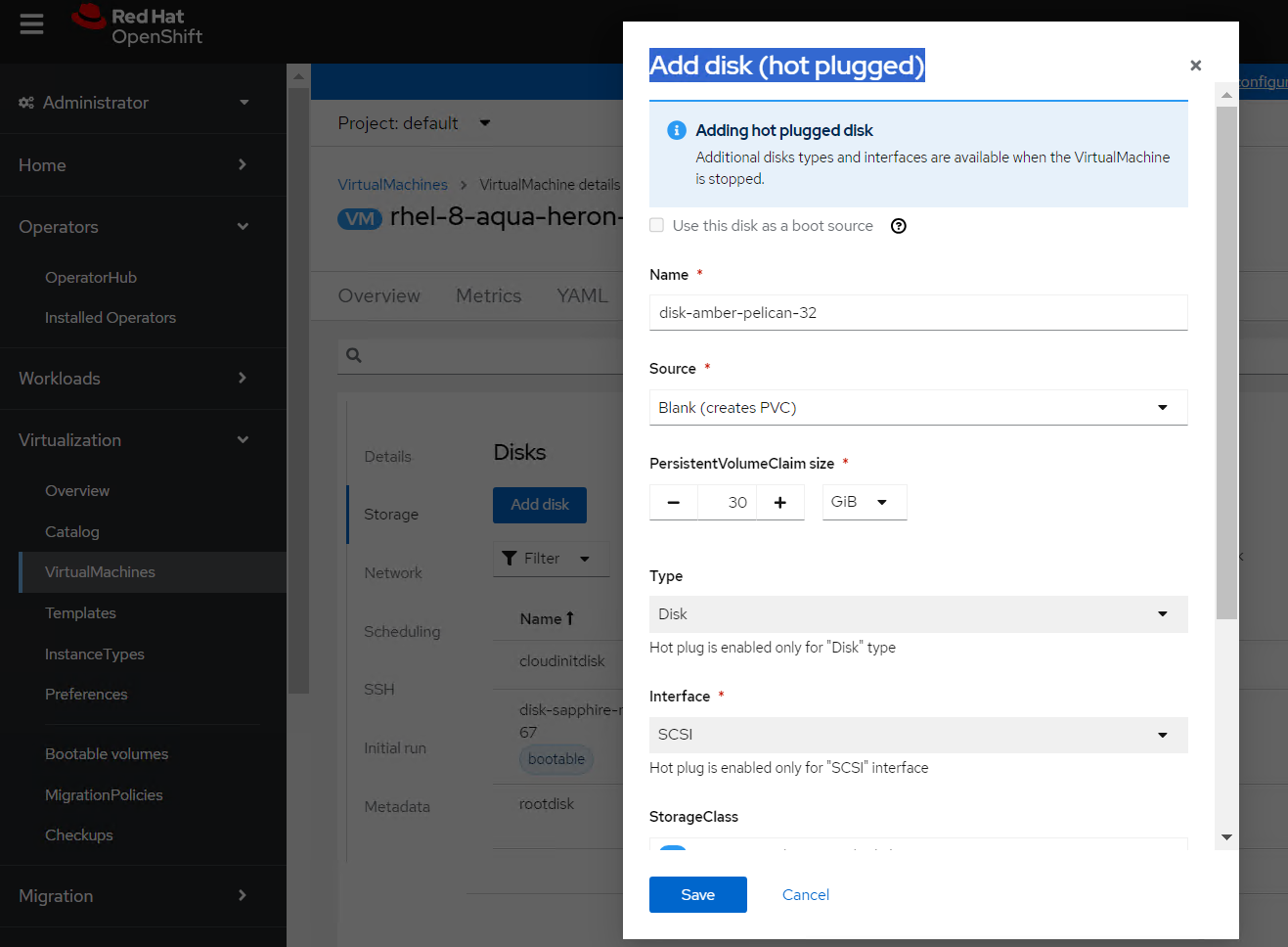
FIGURE 47 Storage disk addition
Specify the fields like Source, Size, Storage class as required
Click Add we can add additional networks, secrets, config map to virtual machines.
Some of the changes are applied once the virtual machine are restarted only. For restarting of any virtual machines navigate to Virtualization → VirtualMachines Click the Options menu beside a virtual machine name and select Restart or select the virtual machine → Actions → Restart
Deleting a virtual machine
You can delete a virtual machine by using CLI or from the web console.
Delete a virtual machine using CLI
- Delete the virtual machine by executing the below command:
oc delete vm < vm_name > -n < namespace >
Delete a virtual machine using web console
Log into the OpenShift Container Platform web console and navigate to Virtualization → VirtualMachines
Click the Options menu
beside a virtual machine name and select Delete or Select the virtual machine → Actions → Delete
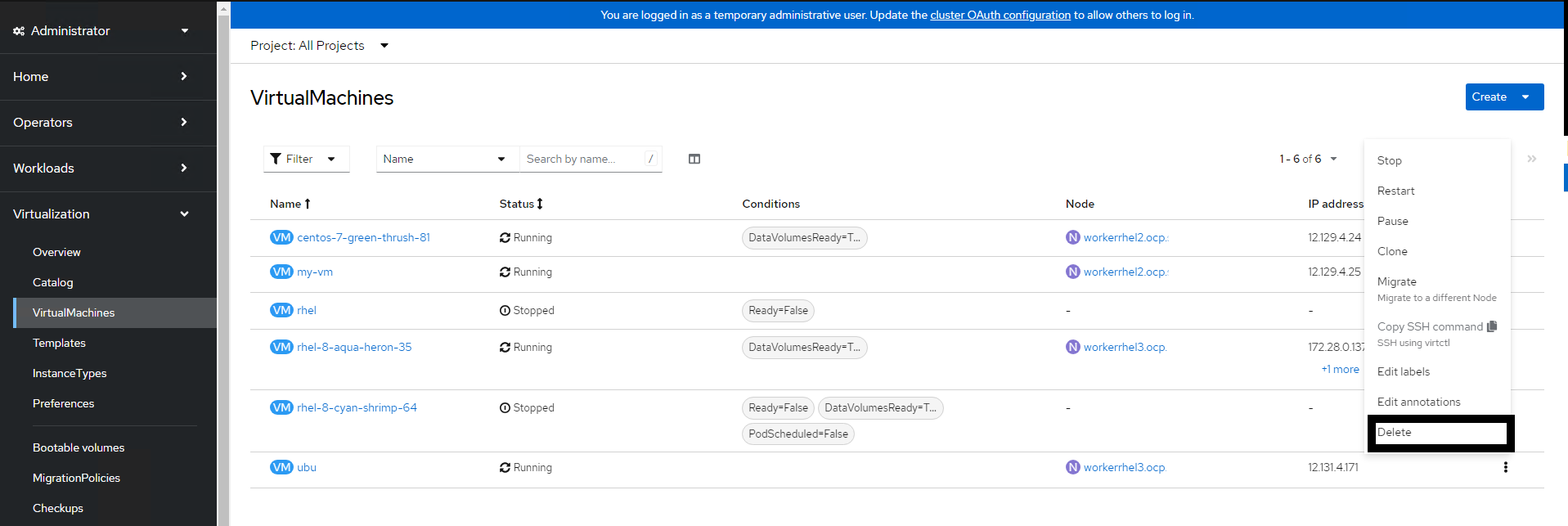
FIGURE 48. Deleting a Virtual Machine
HotPlugging
Hot Plugging vCPUs
Hot plugging means enabling or disabling devices while a virtual machine is running.
Prerequisites:
Required minimum 2 worker nodes in cluster
Steps:
In the Virtualization tab, Navigate to VirtualMachine.
Select a running virtual machine that required changes
Navigate to Configuration tab and Click Details.
Edit the CPU | Memory details
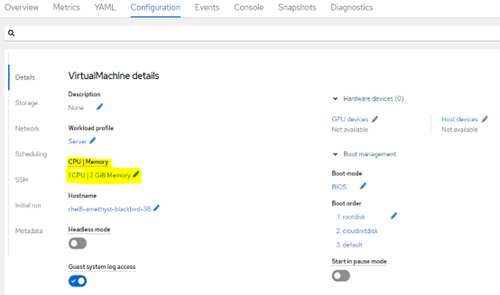
FIGURE 49. Paramter for hot plugging vCPU- 1
- Change the value of Virtual Sockets as required.
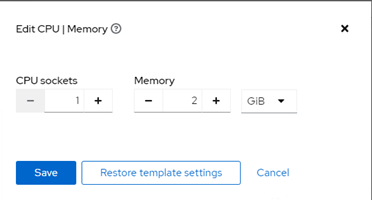
FIGURE 50. Paramter for hot plugging vCPU- 2
- Click Save.
Note: Hot Plugging of CPU and Memory is not possible when Virtual machines are created from the Instance type.
Hot Plugging Memory
You can hot plug virtual memory. Each time memory is hot plugged, it appears as a new memory device in the VM Devices tab in the details view of the virtual machine, up to a maximum of 16 available slots. When the virtual machine is restarted, these devices are cleared from the VM Devices tab without reducing the virtual machine’s memory, allowing you to hot plug more memory devices.
Prerequisites:
Required minimum 2 worker nodes in cluster
Steps:
In the Virtualization tab, Navigate to VirtualMachine.
Select a running virtual machine that required changes
Navigate to Configuration tab and Click Details.
Edit the CPU | Memory details
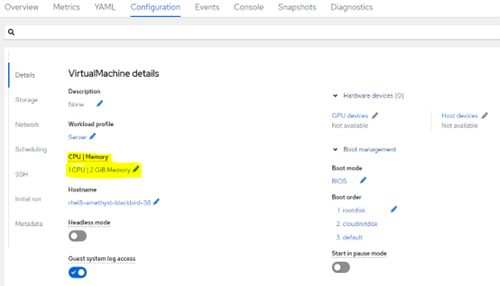
FIGURE 51. Paramter for hot plugging Memory
Change the value of Virtual Sockets as required.
Click Save.
Note: Hot Plugging of CPU and Memory is not possible when Virtual machines are created from the Instance type.
Hot-plugging VM disks
You can add or remove virtual disks without stopping your virtual machine (VM) or virtual machine instance (VMI). Only data volumes and persistent volume claims (PVCs) can be hot plugged and hot-unplugged. You cannot hot plug or hot-unplug container disks.
Prerequisites
You must have a data volume or persistent volume claim (PVC) available for hot plugging.
Steps:
In the Virtualization tab, Navigate to VirtualMachines
Select a running virtual machine that required changes
On the VirtualMachine details page, click Configuration Storage
Add a hot plugged disk:
i. Click Add disk.
ii. In the Add disk (hot plugged) window, select the disk from the Source list and click Save.
Note: Each VM must have Virtio-scsi Controller so that Hot Plug disk can use SCSI bus.
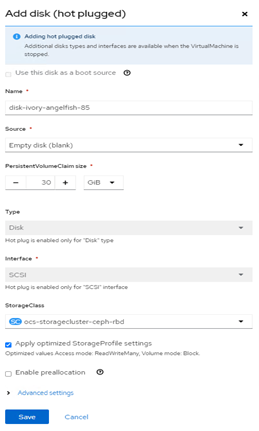
FIGURE 52. Paramter for hot plugging VM disks
Hot-plugging Network Interface
You can add or remove network interfaces without stopping your virtual machine (VM). OpenShift Virtualization supports hot plugging for interfaces that use the VirtIO device driver.
Prerequisites
• A network attachment definition is configured in the same namespace as your VM.
• Required minimum 2 nodes in cluster
Steps:
In the Virtualization tab, Navigate to VirtualMachines
Select a running virtual machine that required changes
On the VirtualMachine details page, click Configuration Network Add network interface

FIGURE 53. Paramter for hot plugging Network Interface
Add the respective Pod Networking (NAD) that needs to be added to network interface
Click Save the network setting.
Navigate to Actions Click Migrate
Once the VM is Successfully migrated to different node. The newly added network interface is available in the virtual machine.
Live migration
Introduction
Live migration is the process of moving a running virtual machine (VM) to another node in the cluster without interrupting the virtual workload. By default, live migration traffic is encrypted using Transport Layer Security (TLS).
An enhanced web console provides a graphical portal to manage these virtualized resources alongside the OpenShift Container Platform cluster containers and infrastructure.
Requirements of Live migration
A dedicated Multus network for live migration is highly recommended.
Persistent Volume Claim (Storage) must have ReadWriteMany (RWX) access mode.
All CPU in cluster which hosts Virtual machines must support the host model.
Configuring live migration
You can configure the following live migration settings to ensure the migration process do not saturate the cluster.
Limits and timeouts
Maximum number of migrations per node or cluster
Edit the HyperConverged CR and add the necessary live migration parameters:
oc edit hyperconverged kubevirt-hyperconverged -n openshift-cnv
sample configuration parameters
apiVersion: hco.kubevirt.io/v1beta1
kind: HyperConverged
metadata:
name: kubevirt-hyperconverged
namespace: openshift-cnv
spec:
liveMigrationConfig:
bandwidthPerMigration: 64Mi
completionTimeoutPerGiB: 800
parallelMigrationsPerCluster: 5
parallelOutboundMigrationsPerNode: 2
progressTimeout: 150
Initiating Live Migration
Live migration of virtual machines can be done using web console or CLI. prerequisites must be met for the live migration of any virtual machines.
Initiating Live Migration using web console
Navigate to Virtualization → VirtualMachines in the web console.
Select Migrate from the Options menu
beside a VM.

FIGURE 54. Live Migration between nodes
- Click Migrate.
Initiating Live Migration using CLI
- Create and apply the VirtualMachineInstanceMigration manifest for the VM
apiVersion: kubevirt.io/v1
kind: VirtualMachineInstanceMigration
metadata:
name: < migration_name >
spec:
vmiName: < vm_name >
Migration Toolkit for Virtualization
Introduction
The Migration Toolkit for Virtualization (MTV) enables you to migrate virtual machines from VMware vSphere, Red Hat Virtualization, or OpenStack to OpenShift Virtualization running on Red Hat OpenShift Virtualization platform.
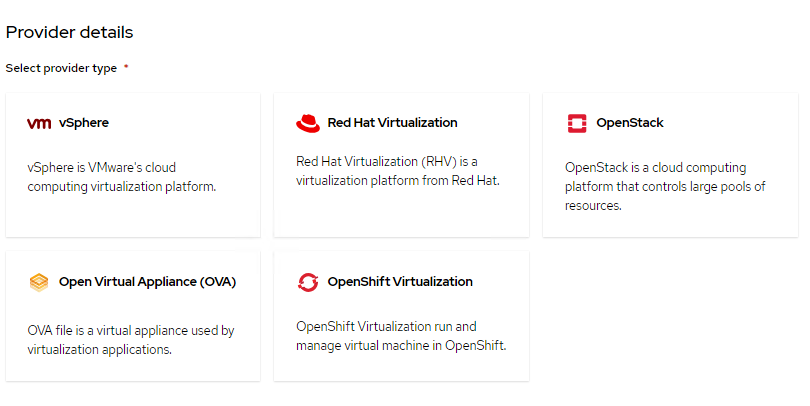 FIGURE 55. Migration Toolkit for Virtualization supported providers
FIGURE 55. Migration Toolkit for Virtualization supported providers
MTV simplifies the migration process, allowing you to seamlessly move VM workloads to OpenShift Virtualization
MTV supports Cold migration which is the default migration type. The source virtual machines are shutdown while the data is copied. Cold migration from
VMware vSphere
Red Hat Virtualization (RHV)
OpenStack
Remote OpenShift Virtualization clusters
MTV supports warm migration from VMware vSphere and from RHV. In warm migration most of the data is copied during the pre-copy stage while the source virtual machines (VMs) are running. Then the VMs are shut down and the remaining data is copied during the cutover stage
Installing MTV Operator
You can install MTV operator using web console and CLI
Installing MTV Operator using web console
- In the web console, navigate to Operators → OperatorHub.
- Use the Filter by keyword field to search for mtv-operator.
- Click the Migration Toolkit for Virtualization Operator tile and then click Install.
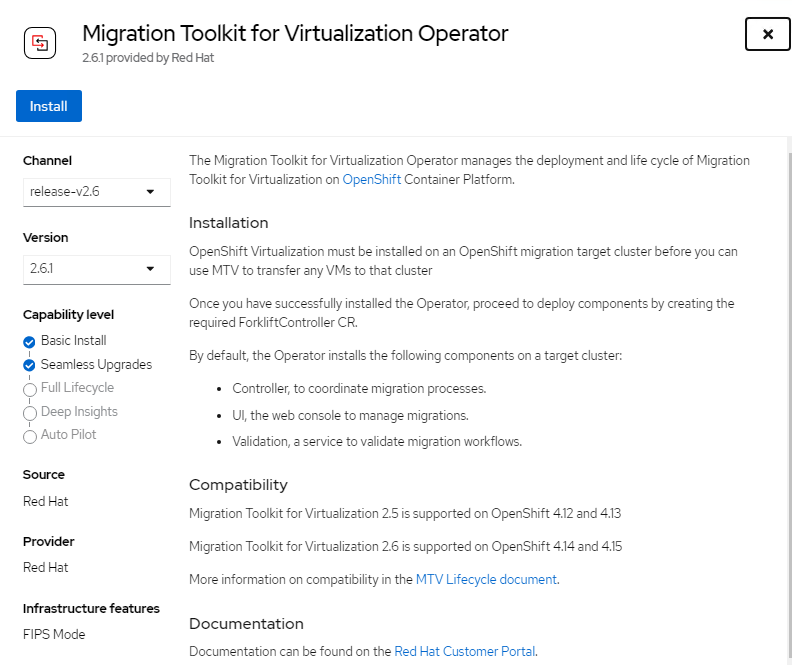 FIGURE 56. Migration Toolkit Operator deployment
FIGURE 56. Migration Toolkit Operator deployment
- After the Migration Toolkit for Virtualization Operator is installed successfully create ForkliftController Instance.
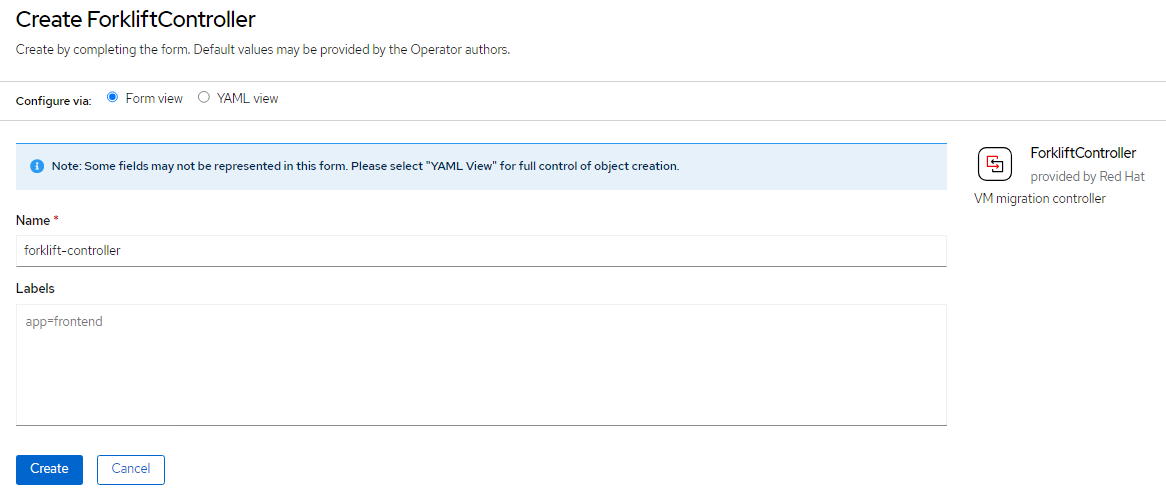 FIGURE 57. ForliftController Instance creation
FIGURE 57. ForliftController Instance creation
Installing MTV Operator using CLI
- Create the openshift-mtv project:
$ cat << EOF | oc apply -f -
apiVersion: project.openshift.io/v1
kind: Project
metadata:
name: openshift-mtv
EOF
- Create an OperatorGroup CR called migration:
$ cat << EOF | oc apply -f -
apiVersion: operators.coreos.com/v1
kind: OperatorGroup
metadata:
name: migration
namespace: openshift-mtv
spec:
targetNamespaces:
- openshift-mtv
EOF
- Create a Subscription CR for the Operator:
$ cat << EOF | oc apply -f -
apiVersion: operators.coreos.com/v1alpha1
kind: Subscription
metadata:
name: mtv-operator
namespace: openshift-mtv
spec:
channel: release-v2.6
installPlanApproval: Automatic
name: mtv-operator
source: redhat-operators
sourceNamespace: openshift-marketplace
startingCSV: "mtv-operator.v2.6.1"
EOF
- Create a ForkliftController CR:
$ cat << EOF | oc apply -f -
apiVersion: forklift.konveyor.io/v1beta1
kind: ForkliftController
metadata:
name: forklift-controller
namespace: openshift-mtv
spec:
olm_managed: true
EOF
Migration of Virtual Machines
You can migrate virtual machines to OpenShift Virtualization by using the MTV web console from following providers:
- VMware vSphere
- Red Hat Virtualization
- OpenStack
- Open Virtual Appliances (OVAs) that were created by VMware vSphere
- OpenShift Virtualization
Adding providers
In web console, navigate to Migration → Providers of Migration → Create Provider
Select the virtual machine provider (in this example we will go with VMWare)
Specify the required provider details
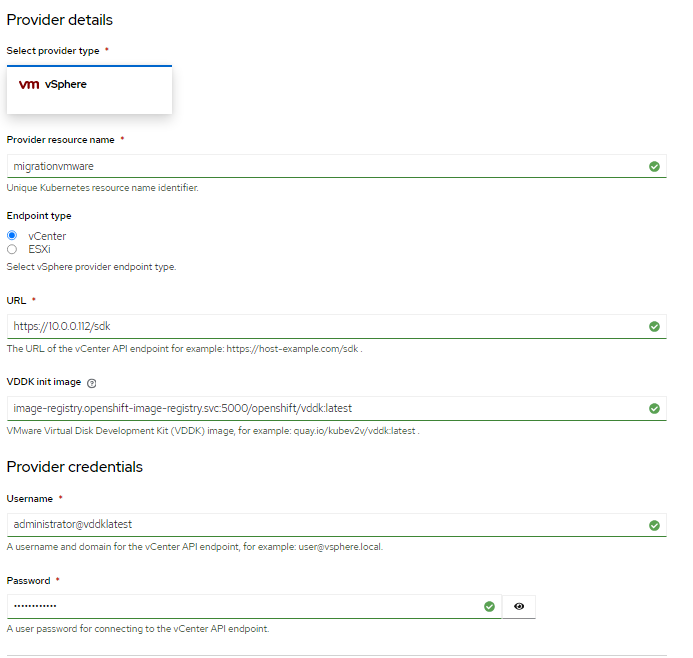 FIGURE 58. Additon of VMWare vSphere
FIGURE 58. Additon of VMWare vSphere
Note: Provider the VDDK init image to accelerate migrations.
Choose one of the following options for validating CA certificates
- Custom CA certificate
- System CA certificate
- Skip certificate validation
Click Create Provider
Selecting a migration network for a VMware source provider
In the web console, navigate to Migration → Providers for virtualization.
Click the host in the Hosts column beside a provider to view a list of hosts.
Select one or more hosts and click Select migration network.
Specify the following fields:
- Network: Network name
- ESXi host admin username: For example, root
- ESXi host admin password: Password
- Click Save.
Verify that the status of each host is Ready.
Migration plan creation
Creating and running a migration plan starting on Providers for virtualization
In the web console, navigate to Migration → Providers for virtualization.
In the row of the appropriate source provider. And navigate to Virtual Machines tab.
Select the VMs you want to migrate and click Create migration plan.
Create migration plan displays the source provider's name and suggestions for a target provider and namespace, a network map, and a storage map.
Provide the required details to the editable fields.
Add mapping to edit a suggested network mapping or a storage mapping, or to add one or more additional mappings.
Mapped storage and network mapping can be viewed in Migration → StorageMaps for virtualization / Migration → NetworkMaps for virtualization
- Create migration plan.
You can create the migration plan for the Source provider as well.
Running a migration plan
In the web console, navigate to Migration → Plans for virtualization.
You can see the list of migration plans created for source and target providers, the number of virtual machines (VMs) being migrated, the status, and the description of each plan.
Click Start beside a migration plan to start the migration.
Click Start in the confirmation window that opens.
The Migration details by VM screen opens, displaying the migration's progress Warm migration only: The pre-copy stage starts. Click Cutover to complete the migration.
Click a migration's Status to view the details of the migration.
The Migration details by VM screen opens, displaying the start and end times of the migration, the amount of data copied for each VM being migrated.
Warm Migration
Warm migration copies most of the data during the precopy stage. Then the VMs are shut down and the remaining data is copied during the cutover stage. Results of a sample ubuntu virtual machine migration with 10GB OS disk and 10GB data disk.
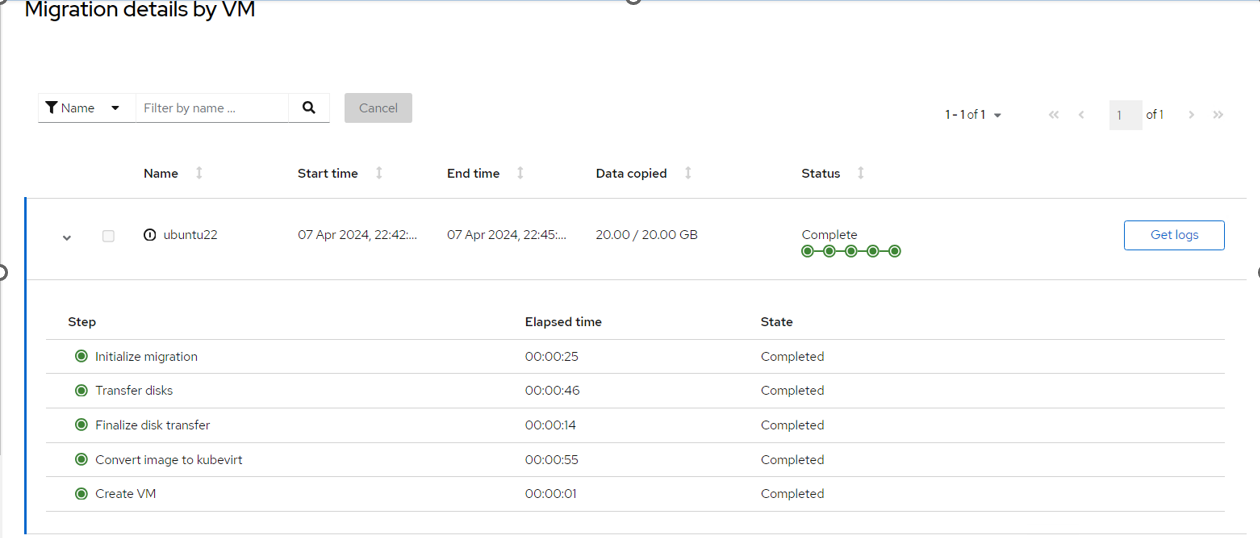 FIGURE 59. Warm Migration output
FIGURE 59. Warm Migration output
Cold Migration
During Cold migration the Virtual Machines (VMs) are shut down while the data is copied. Results of a sample ubuntu virtual machine migration with 10GB OS disk and 10GB data disk.
